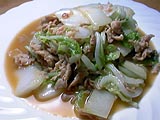Whenever we try to cook Chinese dishes, for some reason (two main ones I can think of), we cannot get the taste quite right. I think the main problems are the following three:
The initial preparation method was introduced in the recipe for Hoy-Cou-Lou, the essential point is Aburatoshi. Heat the oil to a mid-high temperature, then fry the vegetables briefly and take them out. Then, put them back into a pan of new oil which is heated to a very high temperature. The preliminary "frying" procedure is the Aburatoshi, and it makes the vegetable very crisp while they are thoroughly cooked and packed with flavour. Without this preliminary procedure, if you fry vegetables, they will remain either uncooked and raw or overcooked and too soft. By understanding the necessity for this basic procedure, I dare say, you have mastered most of the technique involved in stir fry. However, here comes another problem. For Aburatoshi, you need a special Chinese strainer called Jarlen to drain the excessive oil. Also required is a large lipped oil container. It is not usual for the ordinary household to cook stir fry every day, and therefore, the disposal of oil becomes a bit of headache... It is a shame to know that a little larger kitchen may enable one to cook more delicious Chinese dishes... shame... In my case, I have the strainer but use a frying pan as an oil container. I really hope you would try the vegetable stir fry with Aburatoshi technique. You will taste the reward for your trouble... NB: My friend's father gave us a most impressive Chinese lettuce (6th November 97). Apart from hot pots repertoire, I believe this is the one and only Chinese lettuce recipe to satisfy the kid's enormous appetite. | ||||||||||||||||||||||||
Ingredients (serves: 5-6)
| ||||||||||||||||||||||||
| Cooking time (min) | Pictures | Comments | |||||||
|---|---|---|---|---|---|---|---|---|---|
| 10 - 15 |
| ||||||||
|
Cut the pork into 1cm wide shreds and mix well with ginger juice, soy sauce, sesame oil and salt in a bowl. Then add potato starch and mix them well further. The Chinese lettuce in the photo was a present (please see NB above). Very firm and the leaves are concentrated. An impressive one ... I tried a piece of the white as it is i.e. raw, and by god, it was so sweet! It really was a good Chinese lettuce. | ||||||||
| Anyway, cut the Chinese lettuce as per the photo (2cm wide). If the leaves are too thick, you can break them by bending. The volume of the lettuce may seem too much, but it actually is just enough for the volume of pork. Do not be scared and reduce the volume, or you will have to cry out for further supplies of lettuce later at table. To avoid the disappointment, ignore your present fear and be bold to use the volume of lettuce as indicated here.
(Note: Prepare the seasoning by mixing all the ingredients ready to be used. Chinese recipes require good preparation for speedy cooking.) | |||||||||
| 1 - 2 |
| ||||||||
|
Pour the sesame oil in a large wok. At the temperature of 120-140 *C (250-285 *F), add pork. (The heat of the hob should be low to middle.) Fry the pork for 1-2 minutes, and using the strainer, drain the oil. | ||||||||
| 5 - 8 |
| ||||||||
|
Pour sesame oil into the same wok again, and heat it till smoke comes out. Throw away the oil and pour new oil again (2-3 table spoon). Add the pork (the above Aburatoshi and preliminary wok heat-up techniques help pork not to stick to the pan). When the pork is cooked, add the white parts of the lettuce and stir. When the white part becomes a little tender, add the green part. As you can see in the photo, the wok becomes completely full, BUT this is how it supposed to be. (Don't worry, you are not doing anything wrong there!) | ||||||||
| When the lettuce becomes a little more tender, add the seasoning sauce (pre-mixed as above), stir the whole contents of the wok. Be careful not to overcook the lettuce and take the wok off the cooker before it becomes too tender. By then, the volume of lettuce will have reduced considerably, and I hope you are heaving a sigh of relief and muttering "Thank goodness, I listened to him..." looking at the final product of your effort. | |||||||||
Contents copyright 1996-1998 Mitsuo Sugawara
Translator: MoonCat















